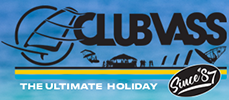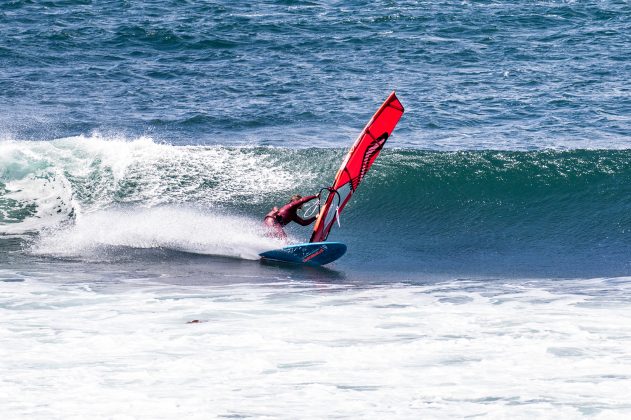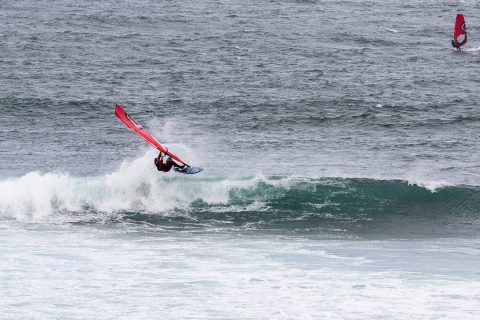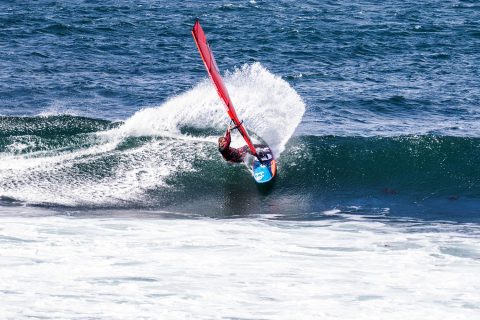FINN MULLEN: MANAGING EXPECTATIONS
Finn Mullen takes a fresh look at how he views his good and bad windsurfing sessions.
WORDS – Finn Mullen // PHOTOS – Katie McAnena
That looked fun”, he said as his dog bounded beside him. The rig was biting at my hands, gusts trying to wrestle it from my grip towards a barbed wire fence. “Yes”, I grimaced, trying to smile while impending doom beckoned. It was a perfect day for dog walking, and windsurfing, though I suspect he didn’t look at the weather forecast as much as I had. Which is of course a perfectly reasonable innocent act to do when you’re land bound. It’s a luxury which mariners aren’t afforded and in the modern ‘information’ age we can be bound by as much information as we wish to saturate our decision making process with. Yet in days of old, ships still set sail, ventured and returned, sometimes! And as windsurfers when we chart the progression of our sport, you could argue that in the milestones of evolution, the advancements in weather forecasting have undoubtedly increased the chances of our own safe return to shore. It has also changed the wiring to some degree of what our central processing unit has come to expect of a session. Based on experience and increasingly, whatever hour-by-hour data we have logged from our favourite forecasting site, we form an idea of what to expect and what gear to bring. Add in a few reports from a local WhatsApp or social media group, and the old classic question of, “What’s it like?”, to any fellow sailors when we get to the beach, and our pre-launch mood can be influenced by multiple sources. Hope, happiness, eagerness, or a darker side! Again I suspect the dog walker has little of this to contend with, other than a quick check that the tail is wagging, there is little to disrupt his temper.
- Finn Mullen action in Ireland
Overload
Information overload is the unfortunate consequence of advancements in information technology. In the maritime and aviation industries, its impact can have serious consequences and has been much studied to prevent the bridges of aeroplanes and ships becoming a dangerously confused hub. In windsurfing, nothing kills the buzz quicker than seeing reports of dying conditions or hearing the words, “You should have been here earlier…” from a ‘windie’ comrade. The latter, for reference, I consider the most heinous of sins to commit! Informal code of conduct transgressions aside, I have learned to try and take the sting out of potentially mind altering reports by using one of the most complex body parts we as humans have – the MK1 eyeball! And for me, it’s just not what I see, but how I choose to see it. It’s a balance, on the one hand you are trying to keep safe – pick the right gear to avoid sinking or getting caught out with too big a sail – and on the other hand pay too much attention to all the information and you can get swept up by a tsunami of thoughts – ‘don’t overthink it’ as a friend often jokes. And sometimes when the weather conspires against you, perhaps humour is the best defence! But what I try and do is look at the conditions with fresh eyes. If the wind is dropping, I remind myself that if I was injured or had not sailed for a number of weeks, then bogging around with a big sail instead of a 4.7 would still be better than not sailing! And even if I miss ‘wave of the day’, those smaller waves are still much bigger than no waves. A session cut short is always longer than the session missed.
Viewpoint
I’m careful too of how I view conditions. Early mornings at Pozo when it’s windy are a prime example. As the wind builds during the day and tired bodies recover, the famed waters of Pozo are often empty of sailors at that time of day. It’s still windy though, 4.0 – 4.2 weather, and if you didn’t know better, you’d wonder why no one is out. Moreover, when it’s devoid of windsurfers, you can look at the sea closely, and observe how it would be the sort of conditions you might drive past in search of somewhere with a better wind angle or waves. And yet, come lunchtime, that same stretch of beach, with not a radical change in conditions, will have on display some of the most explosive windsurfing you will see anywhere in the world! Similarly the PWA event at Sylt often shows what can be done in challenging North Sea conditions that don’t look too dissimilar to a lot of wind swell driven breaks in Northern Europe. Those performances I use as inspiration to what can be done, rather than what I can’t do!
- Finn Mullen slash!
Onshore
Onshore can be tricky, no doubt, but with it comes positives – lots of ramps to practice jumps, flat water between waves to train transitions, and plenty of curls to carve off. Slamming a turn in on a breaking wave on the way in or out, gybing on a just about to break wave or bit of whitewater, Robby Naish style, is a skill that readily transfers to better wave days. And if it’s marginal onshore I’ll take the chance to upskill my ‘chess’ moves – bogging upwind off the plane, and only bearing away in a gust to try and plane, or tacking just as a wave approaches and using the power of the breaking surf to accelerate on the opposite tack. Wave sailing in its many guises of conditions still involves in its most basic form, getting out, turning around, catching a wave and riding it back in. No ride ever happened without that all-important transition and I have missed plenty of rides by blowing it! So I always remind myself on those days when I am wobbling around in onshore off the plane, that the balance and rig handling skills I can still practice are worthwhile and have an increased return when I just do them in a small area a few yards from shore. There I can increase their frequency by confining myself to a self-imposed small area. This has the added benefit of not sailing over a longer distance and risking getting pulled further downwind or down current. And by staying close to shore I can walk by easily if I do get caught out. Setting myself a small target area, I also practice the art of staying upwind and holding station – which is a vital tool in cross-off perfection where you need to remain in a finite area, waiting for sets just upwind of a perfect peak.
FOMO
FOMO, the oh so modern fear of missing out, seems like such a luxurious and indulgent concept given the state of the world at present, and yet it persists. Sailing on a western Atlantic seaboard, subject to the vagaries of an ever-changing airflow, the chances of missing out are almost a given. It’s a bet against the greater powers of wind and sea and a gamble that the house always wins. But playing the game doesn’t mean you have to lose every time. Poet and wise wild Atlantic shore fan, William Butler Yeats, famously wrote his own epitaph – “Cast a cold eye. On life, on death. Horseman, pass by!” When I’m dumped ignominiously back to shore by the cruel combination of a lull in the wind and the rise of a wave, I’ll often think of his words as a reminder that all of this is only temporary. And so reaching into my quiver of armoured outlook and bigger board I’ll try again. Longevity in windsurfing is as much about learning to enjoy the ‘bad’ times as much as the good. ‘Embrace the suck’, as they say in the military! And with that I’ve learned that it’s better not to have a favourite size of board or sail, just enjoy them all. Yes my super duper wave board I love carving and boosting on, but if I didn’t have my trusty freewave board, windsurfing SUP, foil board or old-school Windsurfer LT, I’d be a much-maligned windsurfing soul. But the most important bit of kit I have, is the one between my ears, that one saves many a session. In the pictures of this article, I turned up expecting nothing other than windsurfing. As it happened, conditions were much better than forecast and as I derigged beside the dog walker, I told him he was right – “It’s always fun!”




